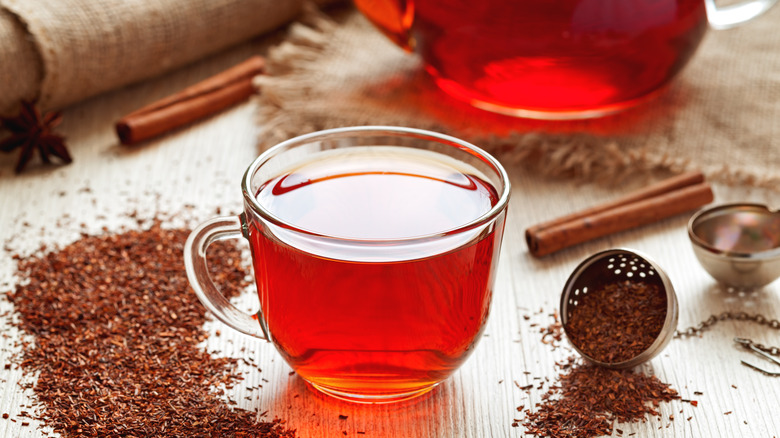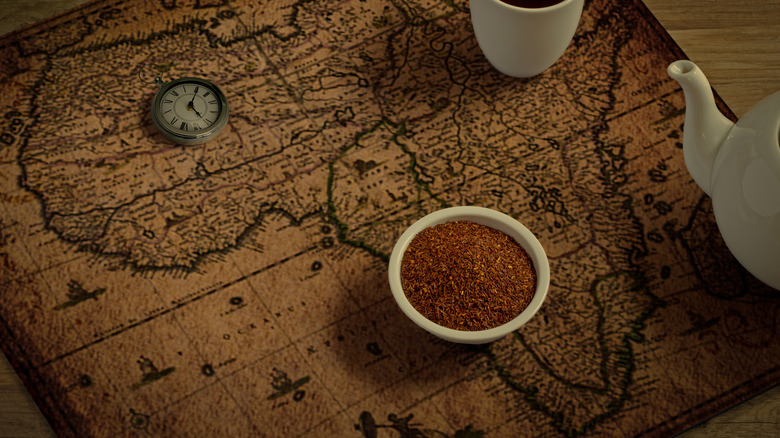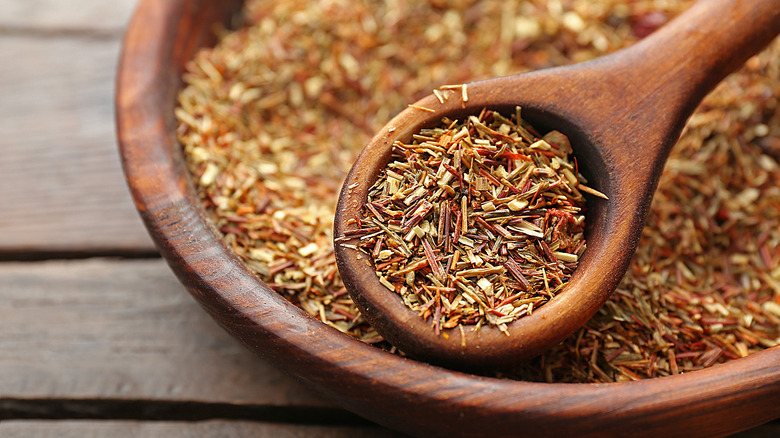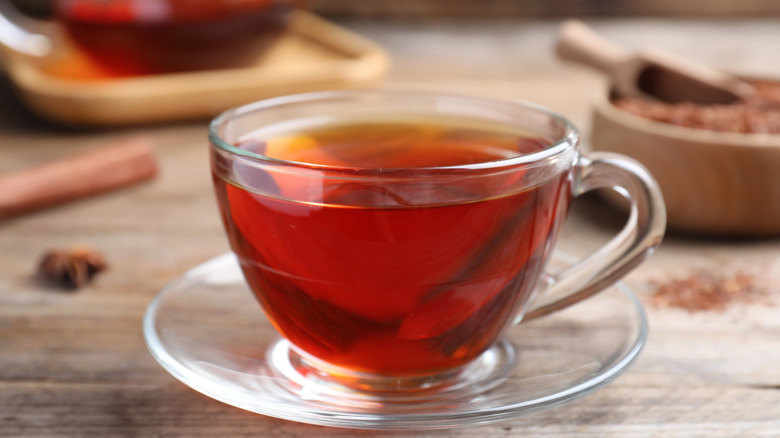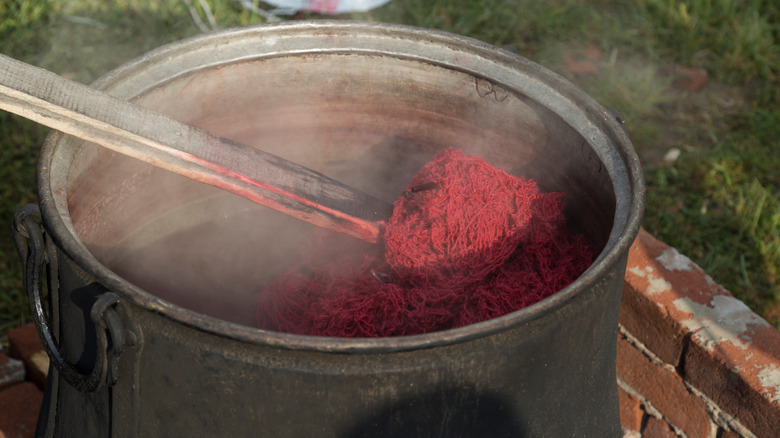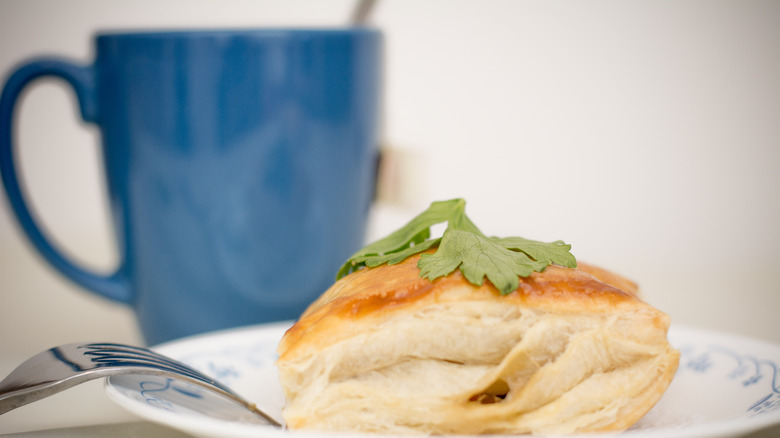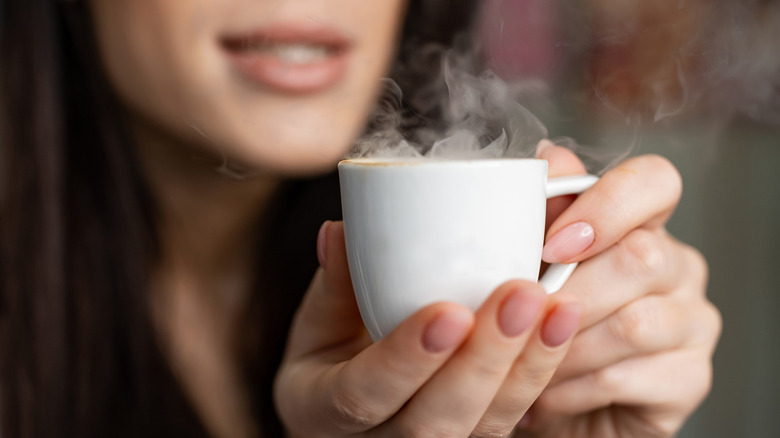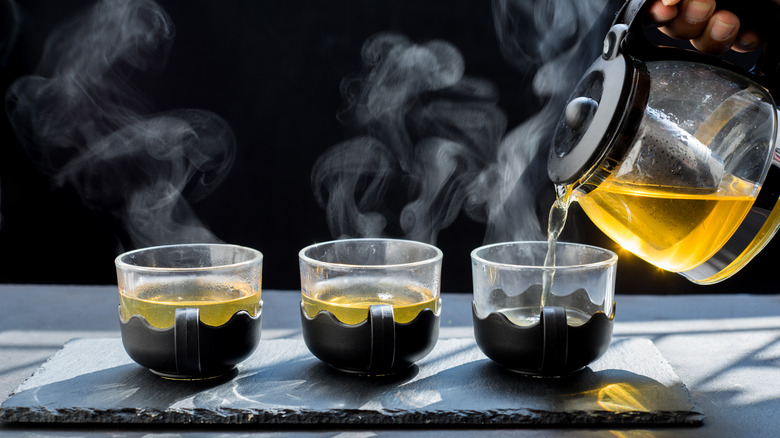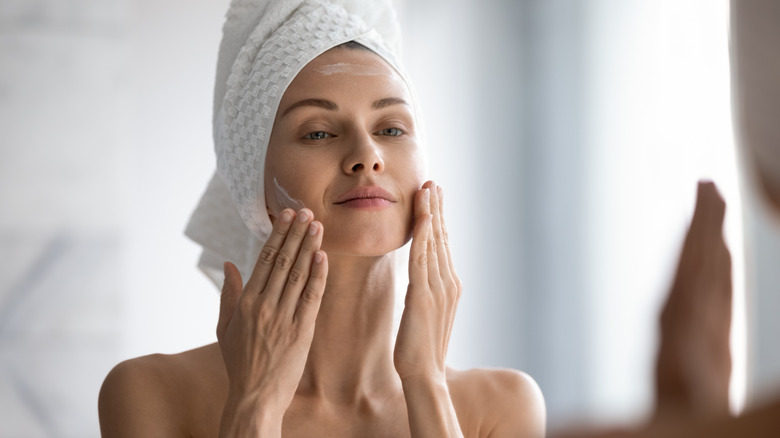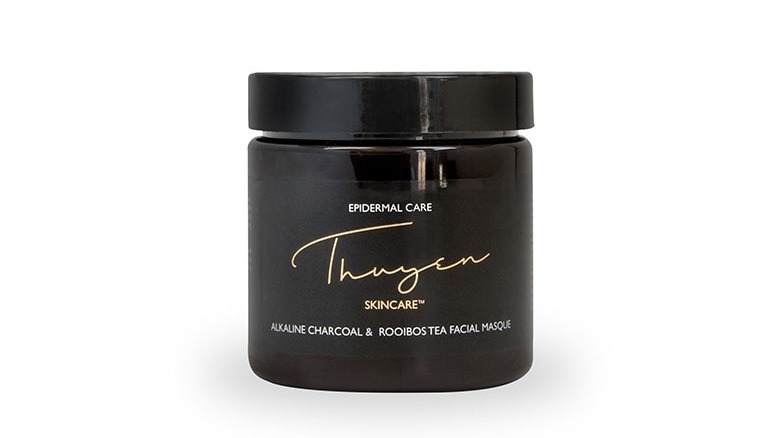What's The Tea About Rooibos Tea?
Rooibos is an increasingly popular herbal tea that comes from the bushy Aspalathus linearis plant and is native to South Africa. The name actually comes from the Afrikaan word for red bush, which refers to the red hue of the sweet-tasting brew. As stated by Rooibos Council, the tea was popularized by Dutch settlers in the 18th century, where it was brewed as a more affordable version of the much pricier black tea. Swedish botanist Carl Thunberg also referred to the tea in his reports at that time, looking at its potential medicinal benefits of rooibos.
Meanwhile, South African Dr. Le Fras Nortier was an incredible pioneer in terms of pushing forward agricultural developments of the germinating potential of the bush in the 20th century, which really gave rooibos tea the ability to spread far and wide, according to the website.
Since these early days, rooibos has made its way into the beauty industry, onto cocktail menus in the U.S., and was even featured on a 2022 episode of "MasterChef SA" where the contestants were challenged by chef Gregory Czarnecki to create an entrée focused around rooibos tea. Ultimately, it's loved by celebrities, and tea drinkers the world over.
With such a rich history from the mountains of South Africa, what you'll undoubtedly want to pour over and know is, what's the tea about rooibos tea?
Rooibos only comes from South Africa
Rooibos is traditionally only grown in one particular area of South Africa: Within the region of Cederberg in the Western Cape, not far from Cape Town. According to News24, this mountainous locale provides just the right conditions for the plant to grow in terms of the climate and the soil, and rooibos is part of the history and heritage of this part of the country.
Per IOL, the indigenous tea has been given geographical indicator (GI) registration, which means that only the leaves grown in this specific area of South Africa can be called rooibos. Protected Designation of Origin (PDO) in the EU, which is afforded to rooibos as a result of this status, protects authenticity and denotes the specific regions where the tea can come from. This mark of how rooibos is produced, processed, and prepared was the first of its kind for an African food and is designed to guard against teas that could be called rooibos that are not. Only real rooibos can carry this authentication, providing exclusivity and support to rooibos farmers.
A Russian immigrant commercialized rooibos as mountain tea
Rooibos may be indigenous to South Africa, but it was actually a Russian immigrant who is thought to be the first to have taken the tea from the fields to the wider market. Per AgriOrbit, Benjamin Ginsberg, whose father was a tea trader in Cederberg, became interested in what was called needle tea. He thus became the first to really use a fermentation method and promote the tea, which he initially did directly to farmers. Meanwhile, it was South African botanist Dr. Pieter Le Fras Nortier, who found a way to germinate the rooibos seeds, thereby allowing the industry to flourish from the 1930s.
As Boris Gorelik, from the Institute for African Studies at Moscow's Russian Academy of Sciences, wrote for SAJBD, Ginsberg was reputed to have marketed rooibos in many ways, after apparently declaring to his wife that he was going to create a "Ceylon of the Cederberg." Taking it from its mountain tea roots to become a world-renowned drink that's exported to many countries around the world, he made the decision to cultivate a brand logo featuring a clock design on the front of packets with the dial pointed at eleven o'clock. According to the website, this was sketched by the so-called father of commercial rooibos tea himself by drawing around his own pocket watch. It was used to reflect the concept of a mid-morning tea-break, or elevenses as it's better known.
Rooibos isn't really a tea at all
While many people refer to it as a tea, rooibos isn't technically a tea at all. According to Teatulia, the reddish "tea" is in fact a dried herb and it comes from a plant that is part of the legume family. The rooibos shrub flowers in spring, with yellow blossoms, which create a seed that ripens and falls. This yellow-flowering plant, which looks like an upside-down broom, survives well in the dry climate of the region. While it doesn't need constant watering, it can also withstand periodic downpours, with these conditions defining the environment in Cederberg, per the website.
As reported by The Whistling Kettle, the tea was first discovered by a tribe indigenous to the Cederberg region. The Khoisan tribe cherished the plant's flavorsome and nurturing qualities, though they primarily used it medicinally for a variety of ailments. In 2019, a "world first" agreement was made to ensure that the tribe receives a yearly percentage of profit from the rooibos industry, in respect of their contributions to it, per BBC.
Following the Khoisan's discovery of the plant and the subsequent enjoyment of it by Dutch settlers, it was another couple of centuries before rooibos was introduced as an herbal tea and an industry established for it. This meant there was lots of time for the heritage of rooibos to brew and develop over time into a rich blend full of interesting properties that researchers are still exploring to this day.
Make the perfect rooibos brew
As with any tea, how it's brewed, and for how long, is a matter of taste. Then, there's the decision of whether to add any milk or cream, and whether to sweeten it. SF Gates notes how general advice seems to be to put a teaspoon and a half of tea into around 8 ounces of boiling water, and that this should steep for "at least" 5 minutes. Whether you like to drink rooibos hot or cold, it's not clear whether milk could diminish its antioxidant properties, as some research suggests may be the case with green tea. Although, rooibos has a certain sweetness to it, honey or sugar can be added to boost the taste.
The Exotic Teapot notes that the tea was traditionally heated up in water, rather than having boiling water added to the rooibos leaves, with the blog recommending a brewing time of half an hour for the perfect cup, along with a drop of milk. There are no hard-and-fast rules when it comes to brewing the perfect rooibos. However, it's no doubt helpful to think of it a little differently than your classic cup of breakfast tea or herbal tea, which many tea-drinkers are known for simply dunking in a cup of hot water for a few minutes.
Is rooibos good for you?
There are purported to be many health benefits associated with rooibos tea, making it a great substitute for coffee, with no bitter-tasting tannins. WebMD suggests the rooibos is a good source of fluoride and copper, while also being rich in antioxidants and polyphenols, which can provide anti-inflammatory qualities. Inflammation is potentially linked with a number of dangerous health issues, including heart disease, and therefore rooibos could be of a possible benefit to cardiovascular health.
Another antioxidant in rooibos is aspalathin, with research looking into how this may be linked with lowering blood sugar, according to the website. Due to the way rooibos is processed, there are higher amounts of aspalathin in the green rooibos variety, as opposed to the red. Because of possible impacts on lowering blood sugar, this may mean that rooibos could help to prevent or control diabetes.
According to Verywell Health, research is ongoing into how immunomodulator properties in rooibos may even impact certain types of cancer. Studies suggest there may also be evidence to support rooibos as having some effect on blood pressure. Which, along with reduction of oxidative stress, could be beneficial to guard against heart problems. However, rooibos has shown to be active in boosting estrogen levels, which — when drank in large amounts — may not be beneficial for women with hormonal issues and certain estrogen-reactive cancers, per Healthline.
You can make a rich red dye from rooibos
There's more to rooibos than a teapot and a cup of tea. The rich coloring of the red bush makes it perfect for use when creating natural dyes for wool and yarn. Not only is this a creative way for you to use rooibos, but it's a really fun handicraft you can try at home too, using natural ingredients.
Numi suggests you soak wool in water overnight, while boiling eight rooibos tea bags in 8 cups of water for 10 minutes, before cooling down. After leaving the yarn for an hour in a one-to-four parts water and vinegar mix, carefully put the yarn into the rooibos liquid. Bring this to a simmering point, without actually boiling, for 90 minutes. Let this cool before rinsing the wool under cold water until it runs clear and then hang the yarn up to dry.
Another similar method, offered by Natural Suburbia, tells you to leave the teabags in the liquid the whole time and also to leave the wool in the cooled-down dye for a few hours before rinsing. When you use vinegar, you are effectively making sure that the color of the rooibos adheres to the wool. So, in effect, it's a fixing agent.
You can even cook some rooibos recipes
Brewing the perfect cup of tea or dyeing wool with its red bush hue is one thing, but what about trying to cook with rooibois? A small collective of famous South African chefs created a recipe book featuring 100 dishes incorporating the South African tea in some way. Called "A Touch of Rooibos," the collection features variations on classics such as a Rooibos Chicken Pot Pie and also Mussels in Rooibos-Pernod Cream Sauce, per Teatulia.
Rooibos Council also has some pretty interesting culinary ideas, too. One such recipe, Rooibos Lentil Bobotie, is based on a classic South African dish. Fry two chopped onions, a tablespoon of grated ginger, and a clove of crushed garlic in olive oil until soft. Add a grated sweet potato, 4 teaspoons of curry powder and ground cumin, 2 teaspoons of ground coriander, and a teaspoon of ground turmeric. Fry until aromatic, turn down the heat, and add a cup of uncooked brown lentils with two cups of strong rooibos tea. Simmer for 30-40 minutes. Add a third of a cup of raisins, eight teaspoons of red wine vinegar, and half a teaspoon of salt. Season with lemon juice and black pepper. Put in an ovenproof dish, and pour on a mix of two eggs with a cup of buttermilk. To finish, sprinkle with bay leaves and flaked almonds and bake for 30 minutes at 180.
Rooibos made into the world's first tea espresso
While rooibos may not strictly be a tea, it's certainly nowhere close to being a coffee. However, that's not stopped the coming together of two much-loved beverages to create the red espresso. Winning multiple awards, with a focus on pioneering healthy café culture, the unique rooibos grind is so fine that it means you can use it in your coffee machine. In other words, you can make a hot rooibos drink in the same way you'd use coffee to make an espresso, whether with a machine or on the stovetop. The brew that's produced has "a stronger, richer Rooibos taste complete with a golden crema," according to the brand's explanation about what makes red espresso so special.
The company behind the innovative drink also suggests that a 60 ml shot of the rooibos espresso has more antioxidants than both regular rooibos, by ten-fold, and also five times the amount of antioxidants than in green rooibos. Meanwhile, I Need Coffee offers a couple of tips when making red espresso after experimenting with taste and technique. The first is to not pack in the grind hard, so just tamp the grinded rooibos to make it level. Secondly, don't fill too much before tamping either, again making the grind level. Red espresso may be the world's first espresso tea, but you can also use it to make cappuccinos and lattes too.
What's different about green rooibos?
While you may have heard of rooibos, and hopefully tried it too, have you heard of green rooibos? They both come from the same plant but have different processes of oxidation. According to Simple Loose Leaf, the green variety is harvested and then dried straight away, giving the tea variant its differing hue and unique flavor, while also boosting its antioxidant value. In other words, unlike red rooibos, your green variety isn't oxidized. However, don't confuse green rooibos with green tea, since they're not the same. A major difference being that the latter contains caffeine which makes it less bedtime-brew friendly for tea lovers, per the website.
An Experience Tea article describes the taste of green rooibos as being "mild" with "a malty flavor." This means it can be successfully blended with others, although it can also be brewed just as it is. The mellow taste of green rooibos is not just great-tasting, there's ongoing research into the health benefits of the herbal brew too. Medical Xpress highlights a study into the unfermented rooibos, which is what green rooibos is, and how it could help reduce anxiety because of its anxiolytic properties. Interestingly, the research involved zebrafish which have many of the same disease-causing genes as humans, and was carried out at the Zebrafish Research Unit, at Stellenbosch University's Faculty of Medicine and Health Sciences.
Red wine made from rooibos wood chips
South African boutique winery Audacia produced the first rooibos red wine in 2014. Preservative-free, the wine is made using rooibos toasted woodchips and honeybush, alongside a revolutionary process that allows plant tannins to be used so that there's no need to add sulfur to the wine. This natural preservation means that a plant that's rich in antioxidants can be used instead of traditional preservatives, with a 2013 Merlot using this method first.
The idea came after wine farmer Trevor Strydom was given a cup of regular rooibos to drink by his daughter, per Business Insider. He was apparently feeling fatigued while searching for a different ingredient to use in winemaking, when he arrived upon the notion to use the indigenous plant. Along with winemaker Michael van Niekerk, they experimented with how wine would interact with the herb. The pair put rooibos teabags in red wine to start with, and soon discovered that this meant they could cut down on adding sulfites which can cause allergies.
Rooibos is touted for anti-aging qualities
Outside of South Africa, the tea has also been a big hit in many other countries, and especially so in Japan. In 2018, over 2,000 tons of rooibos tea was shipped to the country out of 18,000 tons produced, with half of the total shipped to over 30 countries across the globe. The Healthy Eating Site further reveals how Japanese consumers regard rooibos as an anti-aging tea because of its antioxidant properties and quercetin which is "believed to have potent anti-inflammatory properties." Studies carried out into rooibos in the 1960s discovered these antioxidants were similar to superoxide dismutases (SODs), which are known to defend against oxidative stress within the body.
South African Rooibos Council (SARC) chairperson, Martin Bergh expands on the popularity of rooibos in Japan in a SARC article. "Among the youth, our homegrown brew is also gaining traction as a ready-to-drink or frozen beverage, middle-aged women consume it specifically for its beauty and age-defying benefits, while the elderly drink it as a sleep elixir," the SARC chairperson explained. "The majority by far still favors the red, fermented Rooibos, but there is a growing interest in unfermented, green Rooibos too. Rooibos is also a popular product in cosmetics, food and puddings, as well as liquor."
A sickly baby inspired the mother of rooibos
If Benjamin Ginsberg is the Father of Rooibos, then Dr. Annique Theron is undoubtedly the mother of rooibos. The South African businesswoman was responsible for developing rooibos-based health and beauty products and creating an internationally renowned brand, Annique. Her relationship with rooibos began in the late '60s, when trying to soothe her baby who had colic and had an allergic reaction to milk. The story goes that she warmed some rooibos in a bottle and, according to her, Theron's child finally slept peacefully through the night. This was what inspired her to set up and launch Annique in 1971, a tea-based health and beauty business which unveiled and promoted the purported anti-allergy and healing benefits of rooibos. She later incorporated the tea into her beauty line too, making her the name and face associated with rooibos.
A winner of the Best Woman Inventor of the Year Award in 1997, while Theron's claims may not be substantiated, she was successful in growing her business into a company boasting thousands of consultants across the globe and exporting to 18 countries. Certainly, rooibos was around way before Theron spoke out about its possible benefits, but her passion for the tea and its power was arguably a big help in putting rooibos on the world map in new and exciting ways.
A natural clean beauty product
In a Longevity article concerning the rise of rooibos beauty products, SARC spokesperson Adele du Toit noted the transition of rooibos from a health shop product to its wider appeal. "It was very niche and not taken seriously by the beauty industry, but now sleek new natural alternatives to mainstream beauty products are exploding onto the scene." The "beauty guru" suggested that there is a real interest in "clean beauty" wherein consumers are seeking out new brands with different values. "This is part of a larger generational shift in younger consumers seeking out locally made, artisanal, natural products in all consumer categories," she explained.
As detailed by Vogue Business, the COVID-19 pandemic may have inspired individuals to focus more on beauty regimes at home, as opposed to going out to a salon. Meanwhile, there is a general shift toward more environmentally friendly products and the use of herbs and botanicals for skincare. This all points toward a growing farm-to-face beauty category of products, with rooibos fitting perfectly with this on-trend concept. As consumers become more aware of ingredients and interested in sustainability, rooibos could become ever-more popular in the beauty industry.
Celebrities love rooibos
It isn't just mere mortals who love rooibos either. The tea has enjoyed long-held popularity among celebrities for decades, too. In fact, the scoop is that actor Catherine Zeta-Jones is said to have served rooibos ice cream at her wedding reception when she wed Michael Douglas back in 2000. Meanwhile, Australian model and businesswoman Miranda Kerr revealed in a Harper's Bazaar interview that she's "really into rooibos tea with goat's milk and a little bit of honey."
Thuyen Nguyen, renowned facialist to stars including Uma Thurman and Eva Mendes, even included an Alkaline Charcoal & Rooibos Tea Facial Masque in his 2018 skincare line. Meanwhile, a 2016 article by Rooibos Council speculated that the red-carpet looks of many Hollywood A-listers could be down to rooibos, with stars like Jessica and Charlize Theron rumored to have enjoyed rooibos treatments at the salon. Angelina Jolie, meanwhile, was said to use Shea Terra's Menthe Orange Organic Shea Lip Butter — a $4 balm featuring rooibos as a key ingredient.
Per the website, SARC spokesperson Ernest du Toit mused on why rooibos has become a go-to beauty ingredient: "Rooibos' high flavonoid content makes it a powerful anti-aging ingredient for skincare formulas. Since much of skin-aging is caused by exposure to UV rays, pollution and other environmental contaminants, Rooibos' free-radical destroying abilities helps to protect the skin and to preserve a more youthful look."
The rise of rooibos fans in the US
Food and Wine called rooibos a "sweet, crowd-pleasing tea" in a 2017 article, featuring an explanation by tea sommelier at New York's Baccarat Hotel, Gabrielle Jammal, as to why rooibos is so incredibly popular in the U.S. "It's got notes of honey and vanilla, it's a little bit herbal, you can have it super light or super strong, and it's got this beautiful color," Jammal explained. The expert also suggested pairing rooibos with chocolate or cheese, and that it can be used in desserts too, such as sorbets. Not to mention, rooibos can be added to gin as a complement to the spirit's natural piquancy.
Meanwhile, Food24 reported in 2015 on a rooibos "cocktail craze" in the U.S., with mixologists adding the tea to their shakers in a trend towards using fewer ingredients with distinct flavors to produce some interesting concoctions. It's even become part of American beer heritage. Chicago brewing company Marz brews Jungle Boogie, an American pale wheat ale using rooibos tea to create a hoppy flavor with a subtle sweetness.
From a flavorful tea to healthy tonic, and beauty products to a culinary and mixology ingredient, it seems rooibos will continue to grow on its fascinating journey, going far beyond what the original rooibos lovers of yesteryear could ever have imagined.
